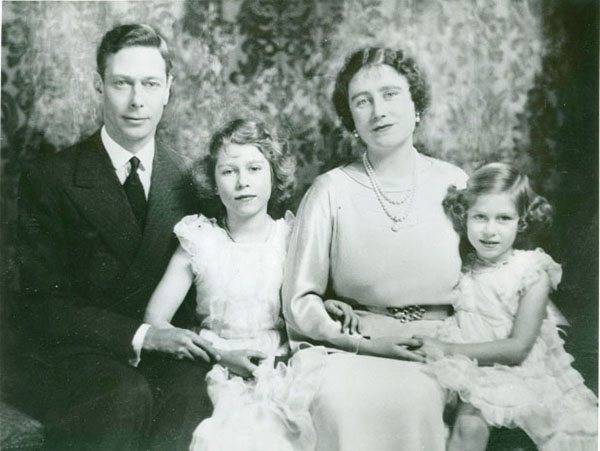Home »

Queen Mum boosted morale in World War Two
Elizabeth, mother of the current queen, died in 2002 at the age of 101, and most of us remember her only as a wrinkled old lady in a veiled hat.
But she was once beautiful enough to attract the son of a king. In 1923 Elizabeth Bowes-Lyon (pictured below left) married the king’s younger son Albert, whom she called Bertie – but only after he proposed three times.
Elizabeth embraced the traditional ideas of family and public service. She became known as the “Smiling Duchess” and gave birth to two girls, Elizabeth (Lillibet) and Margaret (pictured together below).
When Bertie’s older brother abdicated in 1936, Bertie reluctantly assumed the throne. His speech impediment, and the loving support of his wife, were the subject of a 2010 movie titled The King’s Speech, starring Colin Firth and Helena Bonham-Carter (pictured below). Apparently even the current queen was touched by this sympathetic portrayal of her parents.
In 1939 the royal couple took a train trip across Canada (pictured below). My mother June Florence was 15-years-old, and her school class travelled from Battleford to Saskatoon simply to see the couple wave from the royal train.
My mother recalls: “We were waiting on the platform when we saw the King inside, trying to lower the blind on the window. It was stuck, and he was yanking at it with annoyance. Then the Queen appeared, and gently put her hand on his arm and spoke to him, and he turned away. It was obvious she had a calming influence on him.”

 As soon as they returned home, war was declared and Britain – and the royal family – began to fight for their very survival.
As soon as they returned home, war was declared and Britain – and the royal family – began to fight for their very survival.
In a letter, Elizabeth wrote: “I could not help tears running down my face, but we both realized it was inevitable that we must face the cruel Nazi creed and rid ourselves of this continual nightmare.”
Just two months after war was declared, on Remembrance Day 1939, she addressed women around the world on the BBC Radio in a truly inspirational speech (lead image above).
She begins by sending her sympathy “to the women of Poland upon whom the first cruel blows have fallen, and the gallant womanhood of France, who are called on to share with us once again the sorrows and hardships of war.”
Britain was recruiting women into the armed forces for the first time in history, and the Queen praised their efforts.
“War has at all times called for the fortitude of women, even in other days when it was the affair of the fighting forces only. Now all this has changed. For we, no less than men, have real and vital work to do.”
She concludes: “The call has come, and from my heart, I thank you, the women of our great Empire, for the way in which you have answered it.”
The king and queen remained at Buckingham Palace throughout the war, proudly flying the Union Jack and visiting bomb sites.
When she met the survivors from a bombed school, Elizabeth could barely contain herself, writing: “It made me all the more determined to beat those unspeakable Huns to see those little faces, so hurt for the sake of Nazi propaganda. I grind my teeth with rage.”
At one point, a bomb fell on the palace, causing some damage. Elizabeth famously said she was glad to be bombed, “because now we can look the East End in the face.” That area of London near the docks took the brunt of bombing.
But she made no claims to heroism. “I am still just as frightened of bombs as I was at the beginning. I turn bright red and my heart hammers,” she wrote to her niece. “I’m a beastly coward, but I do believe that a lot people are, so I don’t mind! Well, darling, I must stop. Tinkety tonk, old fruit, and down with the Nazis!”
This sweet-faced woman boosted morale so vigorously during the Second World War that Adolf Hitler himself called her “the most dangerous woman in Europe.”
When Germany surrendered on May 8, 1945, perhaps nobody was happier than the royals. You can see the joy on her face in this photograph.

 Elizabeth was just 51 when Bertie died and her daughter assumed the throne. From then on, she was known as “Queen Elizabeth, the Queen Mother,” an odd title that she herself found silly, although she was more commonly known as “the Queen Mum.”
Elizabeth was just 51 when Bertie died and her daughter assumed the throne. From then on, she was known as “Queen Elizabeth, the Queen Mother,” an odd title that she herself found silly, although she was more commonly known as “the Queen Mum.”
She continued to live with optimism and serve with dignity. While the rest of the family squabbled and divorced, she served as example to the younger generation.
And continued to wear her beloved hats.
I can just hear her saying: “Tinkety tonk, old fruit, and down with the Nazis!”

– Career journalist and bestselling author Elinor Florence of Invermere has written two wartime books. Her novel Bird’s Eye View tells the story of an idealistic Saskatchewan farm girl who joins the Royal Canadian Air Force and becomes an interpreter of aerial photographs. My Favourite Veterans is a non-fiction collection of interviews whose stories appeared previously on e-KNOW, including Cranbrook’s own Bud Abbott.
Elinor’s new novel Wildwood, about pioneer life in the Peace River, Alberta region, will appear in February 2018. It is available for pre-order now at a reduced price on Amazon. For more information about all three books, visit Elinor’s website at www.elinorflorence.com or call her at 250-342-1621.








